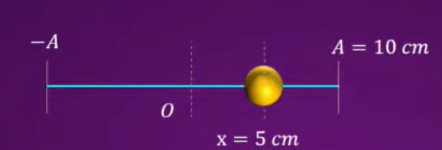A particle performing SHM with A = 10cm is given impulse at x = 5cm such that velocity becomes three times. Find new amplitude. 
Step by step video & image solution for A particle performing SHM with A = 10cm is given impulse at x = 5cm such that velocity becomes three times. Find new amplitude. by Physics experts to help you in doubts & scoring excellent marks in Class 12 exams.
Updated on:21/07/2023Topper's Solved these Questions
Similar Questions
A particle performs SHM with a period T and amplitude a. The mean velocity of the particle over the time interval during which it travels a distance a2 from the extreme position is xa2T. Find the value of x.
View SolutionFor a particle performing SHM, equation of motion is given as d2dt2+4x=0. Find the time period
View Solution
Knowledge Check
The two particles performing S.H.M. have a phase difference of π. If the amplitude of second particle is three times the amplitude of first particle, then the amplitude of resultant motion will be
Aequal to initialBthree times initialCtwice the initialDhalf of the initialA particle performs SHM with a period T and amplitude a. The mean velocity of particle over the time interval during which it travels a/2 from the extreme position is
A6a/TB2a/TC3a/TDa/2TA particle performs SHM with a period T and amplitude a. The mean velocity of the particle over the time interval during which it travels a distance a/2 from the extreme position is
Aa/TB2a/TC3a/TDa/2T
A particle performing linear S.H.M. has maximum velocity of 25 cm/s and maximum acceleration of 100cm/s2. Find the amplitude and period of oscillation. (π=3.142)
View SolutionA particle is performing SHM. At what distance from mean position, the velocity of the particle becomes half of the maximum velocity ?
View SolutionA particle is performing SHM with amplitude 2 cm. At what distance from the equilibrium position is its energy half potential ? What is the maximum velocity of the particle if the frequency of its oscillation is 50 Hz.
View SolutionA particle performs SHM with an amplitude of 5 m. If at x = 4 m, the magnitude of velocity and accelertion are equal, then the time period of SHM (in seconds) is
View SolutionA particle is performing a linear S.H.M. If at time t=0, its displacement is 1 cm, its velocity is πcm/sec and its angular frequency is πrad/s, then the amplitude of its motions is
View Solution
